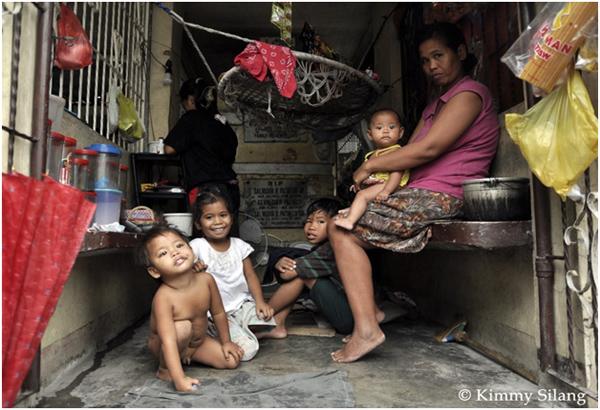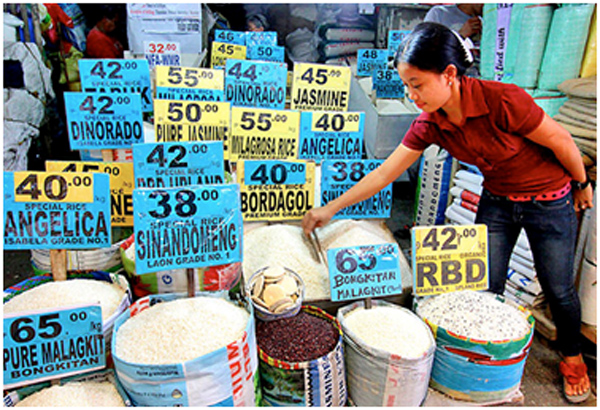Inflation is Eating Our Lunch

Here’s the puzzle: why, amid rising growth, is there also rising poverty? The latest Annual Poverty Indicator Survey suggests that poverty incidence among individuals rose by 1.2% from the first half of 2013 to the first half of 2014. Does this mean that government anti-poverty policies have failed altogether? The answer, it seems, is somewhat more complicated. The answer, in fact, may have to do with the price of food itself.
What exactly does this mean? Well, income is on the rise. But then again so is poverty. Of the many lessons to be derived from a recent National Economic Development Authority (NEDA) report, these contrary developments are particularly glaring. Our “poverty line” is drawn according to a calculated level based on the cost of living — food, shelter, clothing, education and other basic needs. The number of poor increases as the cost of living rises, putting more people below the higher poverty line. Despite improved income, rising food prices have generated a 1.2 percent increase in poverty incidence between the first semesters of 2013 and 2014. The goal, of course, is decrease rather than increase.
Though there are many particulars to discuss about the recently released “Preliminary Report on Official Poverty Statistics of the Philippines for the First Semester 2014,” one fact is already fairly obvious: we all eat rice. For the poor, roughly 20 percent of their income goes to buying vegetables and rice. And rice has, at nearly 12 percent, the highest inflation rate of all. It is closely followed by vegetables, at over 10 percent. (Education, at 4.8 percent, has the third highest inflation rate, but that awaits another column.)
In this preliminary report, NEDA Secretary Arsenio Balisacan pulls no punches: “…the target reduction in poverty incidence for 2014, as indicated in the updated Philippine Development Plan, has not been met.”
That said, it might be worth unpacking some of the features of the report to see what we are doing right, what we are doing wrong and how we can do better at lowering poverty incidence.
Extreme poverty — those unable to meet their basic food requirements — only increased by 0.1%, however. The fact is, inequality is gradually being reduced. The lowest 30% of the population experienced above-average growth in income —about 7.3% per capita compared to the 6.4% average overall — with the highest gains right in the middle: the fifth ranked decile (decile being one tenth) increased by 8.5%. The slowest income growth was in the top two of the ten, with a 5.4% increase in the next-to-top and 4% for the top decile. This, at least, is movement in the right direction.
What needs examining is how and why inflation — especially of food prices —came to eat those gains. Why are food prices so high? Typhoon Yolanda was a big factor that showed up here. Commercial and market food production was wiped out across a wide swathe of the islands. Additionally, there was an unusually long dry season to deal with. But, on top of these natural factors, we also failed to import sufficient rice to stabilize prices.
Insufficient infrastructure is another contributor to the price problem. Besides the massive damage infrastructure sustained from natural disasters during the time covered by the report, the lack of farm-to-market-roads, and post-harvest and food-processing facilities in general not only hamper our ability to get food from where it’s grown to where it’s consumed; they also discourage increased commercial farming.
The report continues, “The 2014 data show that economic growth has benefitted the lower income groups, including the poor. This means that the twin strategies of encouraging investments and production, and the implementation of a large-scale income redistribution program has worked. However, the very high prices of food wiped out these gains.”
Among the things that helped those twin strategies ameliorate what could have been a much deeper descent into poverty were the final days of the ill-fated DAP program that accelerated government spending on infrastructure and inclusive growth during the period covered. However, that program was declared unconstitutional last year, with a chilling effect on many government agencies that resulted in the government underspending the budget by a high 13.3%. (http://www.philstar.com/opinion/2015/02/23/1426576/dap-and-politics-budgeting).
Yolanda recovery programs were among those that suffered. The massive storm wiped out 53% of sources of livelihood in the stricken areas, including farming and fishing, affecting 85,230 Micro, Small and Medium Enterprises (MSMEs), 705,495 farmers, 98,684 fisherfolk, and 32,000 fishing boats. Furthermore, the storm surge took a great toll on the infrastructure of affected areas, destroying billions of pesos worth of private and public properties. The Post-Disaster Needs Assessment Report suggests that the government needs close to P30 billion to put things back together — “Build Back Better” — including more than 1 million houses for 4.4 million affected Filipinos.
Government social programs, especially the Conditional Cash Transfers, have had the effect of containing the incidence of poverty. However, the amounts of cash grants have not kept up with the rise of inflation. In fact, the report suggests, between June 2013 and June 2014, grant spending even contracted by 31.2%. Why this reduction in disbursement at a time of great need? The reason lay in the length of time required to complete, validate and check the accuracy of the beneficiary list. And with household allocations unchanged since 2008, the rise in inflation has significantly eroded the purchasing power of the very poor.
As a result of inflation, we know that official poverty rates have increased by 1.2 percent for the first semester of 2014 compared to the same period in 2013. Without the interventions encouraging foreign investment and inclusive growth, things could have been significantly worse. One thing the report clearly shows is that inclusive growth is possible and that we are doing a number of things to improve it — without the rise in income levels among the bottom third of the population, the effects of inflation could have been much more difficult for all of us.
But the single most significant element of the report has to do with rice itself. It calls for a revision of our rice self-sufficiency program. The quantitative restrictions on rice supply will need to be reconsidered in light of its broader impact on food prices and poverty. More importantly, it calls for the abolition of the National Food Administration monopoly on rice importation.

Simply put, poverty rates will continue to rise unless the rising cost of food, especially rice, can be controlled. NEDA Secretary Balisacan puts it this way: “Food price inflation was the main culprit. The very high prices of food wiped out the gains in per capita income of poor Filipinos. If not for this inflation, we would have had inclusive growth. It seems we may have mismanaged the food supply and distribution system entirely.”
More in my next column.
- Latest
- Trending





























